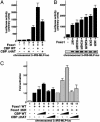Silent information regulator 2 potentiates Foxo1-mediated transcription through its deacetylase activity
- PMID: 15220471
- PMCID: PMC454161
- DOI: 10.1073/pnas.0400593101
Silent information regulator 2 potentiates Foxo1-mediated transcription through its deacetylase activity
Abstract
Longevity regulatory genes include the Forkhead transcription factor FOXO and the NAD-dependent histone deacetylase silent information regulator 2 (Sir2). Genetic studies demonstrate that Sir2 acts to extend lifespan in Caenorhabditis elegans upstream of DAF-16, a member of the FOXO family, in the insulin-like signaling pathway. However, the molecular mechanisms underlying the requirement of DAF-16 activity in Sir2-mediated longevity remain unknown. Here we show that reversible acetylation of Foxo1 (also known as FKHR), the mouse DAF-16 ortholog, modulates its transactivation function. cAMP-response element-binding protein (CREB)-binding protein binds and acetylates Foxo1 at the K242, K245, and K262 residues, the modification of which is involved in the attenuation of Foxo1 as a transcription factor. Conversely, Sir2 binds and deacetylates Foxo1 at residues acetylated by cAMP-response element-binding protein-binding protein. Sir2 is recruited to insulin response sequence-containing promoter and increases the expression of manganese superoxide dismutase and p27(kip1) in a deacetylase-activity-dependent manner. Our findings establish Foxo1 as a direct and functional target for Sir2 in mammalian systems.
Figures




References
-
- Brunet, A., Bonni, A., Zigmond, M. J., Lin, M. Z., Juo, P., Hu, L. S., Anderson, M. J., Arden, K. C., Blenis, J. & Greenberg, M. E. (1999) Cell 96, 857-868. - PubMed
-
- Kops, G. J., de Ruiter, N. D., De Vries-Smits, A. M., Powell, D. R., Bos, J. L. & Burgering, B. M. (1999) Nature 398, 630-634. - PubMed
-
- Rena, G., Guo, S., Cichy, S. C., Unterman, T. G. & Cohen, P. (1999) J. Biol. Chem. 274, 17179-17183. - PubMed
-
- Ayala, J. E., Streeper, R. S., Desgrosellier, J. S., Durham, S. K., Suwanichkul, A., Svitek, C. A., Goldman, J. K., Barr, F. G., Powell, D. R. & O'Brien, R. M. (1999) Diabetes 48, 1885-1889. - PubMed
Publication types
MeSH terms
Substances
LinkOut - more resources
Full Text Sources
Other Literature Sources
Molecular Biology Databases
Research Materials
Miscellaneous

